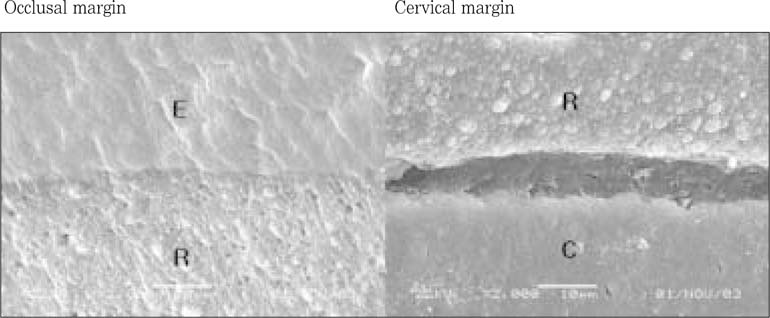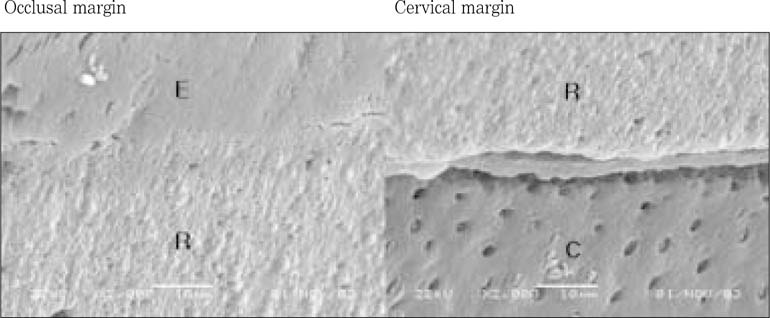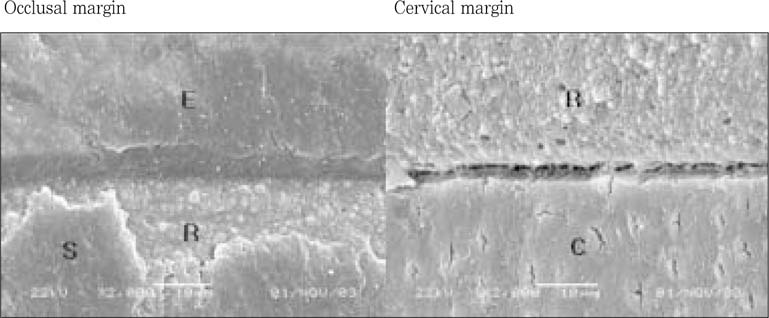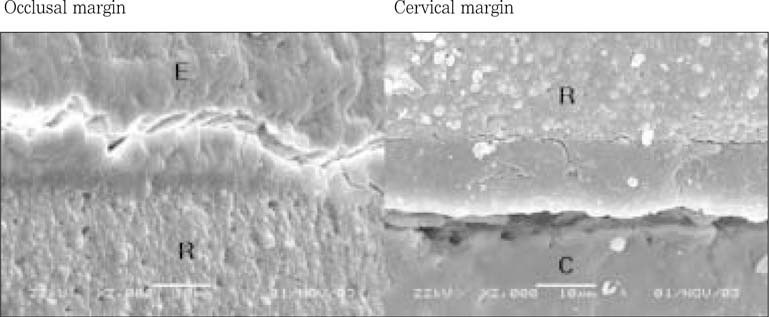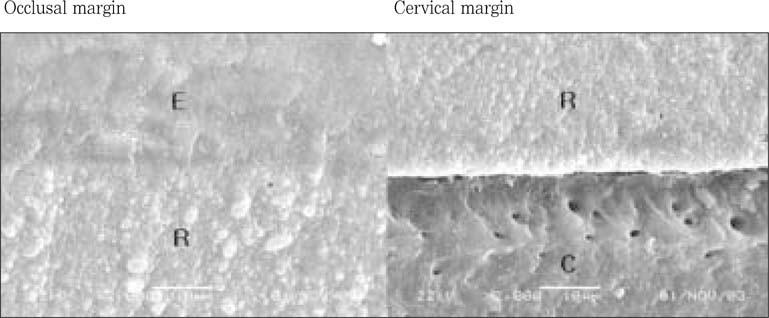J Korean Acad Conserv Dent.
2005 Jan;30(1):22-30. 10.5395/JKACD.2005.30.1.022.
Surface roughness and microleakage of class V composite restorations : Effect of surface sealing
- Affiliations
-
- 1Department of Conservative Dentistry, College of Dentistry, Chonbuk National University, Korea. lkw@moak.chonbuk.ac.kr
- 2Department of Oral Pathology, College of Dentistry, Chonbuk National University, Korea.
- KMID: 1986993
- DOI: http://doi.org/10.5395/JKACD.2005.30.1.022
Abstract
- The purpose of this study was to compare the effect of surface sealing materials on microleakage and surface roughness in Class V composite restorations. Twenty five standardized Class V cavity preparations were made on the facial surface of human premolars and were randomly assigned to 5 groups. The teeth were restored with Z-250 after applying Single Bond. Following 7 days storage in distilled water at 37degrees C, the restorations were sealed as following systems : No sealing ; Single Bond Adhesive ; Biscover ; Fortify ; Optiguard. Then, toothbrush abrasion test was conducted using a wear testing machine. Surface roughness was measured by means of profilometer before and after toothbrushing and the results were statistically analysed by using a paired t-test and ANOVA. The bonded interfaces and the changes of surface roughness were examined by SEM. For microleakage test, specimens were stained in a 2% methylene blue solution, then longitudinally sectioned and analyzed for leakage at occlusal and cervical interfaces using stereomicroscope. The results were statistically analysed by using a Kruskal-Wallis and Mann-Whitney U test. Surface roughness was increasing in all groups after toothbrushing, but no statistically significant differences. In SEM observation, surface sealant was partially retained and partially detached in bonded interfaces. Especially, microgap was identified in cervical margins. In microleakage test, there was better seal in the enamel region and a significant difference between groups at occlusal margin. Control group and Single Bond group had significantly better marginal seal at enamel margin than cervical margin.
MeSH Terms
Figure
Cited by 1 articles
-
Microleakage of 2-step adhesive systems in diamond-prepared cavity
Myung-Goo Lee, Kwon-Hwan Cho, Young-Gon Cho
J Korean Acad Conserv Dent. 2007;32(5):437-444. doi: 10.5395/JKACD.2007.32.5.437.
Reference
-
1. Reid JS, Saunders WP, Chen YY. The effect of bonding agent and fissure sealant on microleakage of composite resin restorations. Quintessence Int. 1991. 22(4):295–298.2. Tjan AH, Tan DE. Microleakage at gingival margins of Class V composite resin restorations rebonded with various low-viscosity resin systems. Quintessence Int. 1991. 22(7):565–573.3. May KN Jr, Swift EJ Jr, Wilder AD Jr, Futrell SC. Effect of a surface sealant on microleakage of Class V restorations. Am J Dent. 1996. 9(3):133–136.4. Ramos RP, Chimello DT, Chinelatti MA, Dibb RG, Mondelli J. Effect of three surface sealants on marginal sealing of Class V composite resin restorations. Oper Dent. 2000. 25(5):448–453.5. Ramos RP, Chinelatti MA, Chimello DT, Dibb RG. Assessing microleakage in resin composite restorations rebonded with a surface sealant and three low-viscosity resin systems. Quintessence Int. 2002. 33(6):450–456.6. Takeuchi CY, Orbegoso Flores VH, Palma Dibb RG, Panzeri H, Lara EH, Dinelli W. Assessing the surface roughness of a posterior resin composite: effect of surface sealing. Oper Dent. 2003. 28(3):281–286.7. Munro GA, Hilton TJ, Hermesch CB. In vitro microleakage of etched and rebonded Class 5 composite resin restorations. Oper Dent. 1996. 21(5):203–208.8. Dickinson GL, Leinfelder KF. Assessing the long-term effect of a surface penetrating sealant. J Am Dent Assoc. 1993. 124(7):68–72.
Article9. Rueggeberg FA, Margeson DH. The effect of oxygen inhibition on an unfilled/filled composite system. J Dent Res. 1990. 69(10):1652–1658.
Article10. Manhart J, Chen HY, Mehl A, Weber K, Hickel R. Marginal quality and microleakage of adhesive class V restorations. J Dent. 2001. 29(2):123–130.
Article11. Kawai K, Leinfelder KF. Effect of surface-penetrating sealant on composite wear. Dent Mater. 1993. 9(2):108–113.
Article12. Doray PG, Eldiwany MS, Powers JM. Effect of resin surface sealers on improvement of stain resistance for a composite provisional material. J Esthet Restor Dent. 2003. 15(4):244–249. discussion 249-250.
Article13. Momoi Y, Hirosaki K, Kohno A, McCabe JF. In vitro toothbrush-dentifrice abrasion of resin-modified glass ionomers. Dent Mater. 1997. 13(2):82–88.
Article14. Svinnseth PN, Gjerdet NR, Lie T. Abrasivity of toothpastes. An in vitro study of toothpastes marketed in Norway. Acta Odontol Scand. 1987. 45(3):195–202.
Article15. Ambjornsen E, Holland RI. In vitro abrasion of two acrylic veneers. Dent Mater. 1994. 10(2):107–110.
Article16. Goldstein GR, Lerner T. The effect of toothbrushing on a hybrid composite resin. J Prosthet Dent. 1991. 66(4):498–500.
Article17. de la Torre-Moreno FJ, Rosales-Leal JI, Bravo M. Effect of cooled composite inserts in the sealing ability of resin composite restorations placed at intraoral temperatures; An In Vitro Study. Oper Dent. 2003. 28(3):297–302.18. Erhardt MC, Magalhaes CS, Serra MC. The effect of rebonding on microleakage of class V aesthetic restorations. Oper Dent. 2002. 27(4):396–402.19. Ehrnford L. Surface microstructure of composite resins after toothbrush-dentifrice abrasion. Acta Odontol Scand. 1983. 41(4):241–245.
Article
- Full Text Links
- Actions
-
Cited
- CITED
-
- Close
- Share
- Similar articles
-
- Effect of resin sealants on the reduction of microleakage in composite restorations
- The Effect of Three Surface Sealants on Microleakage of Class V Composite Resin Restorations
- Effect of biscover on the marginal microleakage of composite resin restoration
- Effect of surface sealant on surface roughness of dental composite with different surface roughness
- Microleakage of the class V cavity according to restoration site and cavity size using SEM and three-dimensional reconstruction techniques


